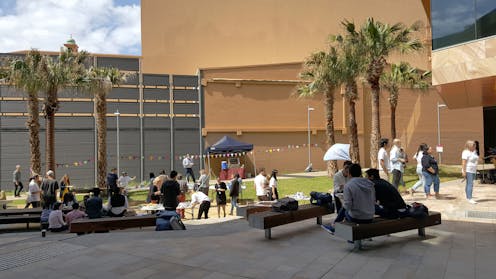International students are back on campus, but does that spell the end of digital learning? Here's why it shouldn't
- Written by Chie Adachi, Associate Professor and Director, Digital Learning, Deakin University

Universities are welcoming international students back to campuses[1] now Australia’s borders are open. So, with these students back in person, is this the end of digital learning at universities? It shouldn’t be.
Continuing multimodal study will be critical for our universities to attract and retain international students whose numbers in Australia halved during the pandemic[2].
Quality of education is now tied to quality of hybrid in-person and online learning. And quality of learning is one of the three top factors[3] international students consider when choosing a study destination.
Rolling back changes isn’t an option
What was normal practice in pre-COVID education might no longer adequately prepare students for the future.
Our lives and the world of work continue to digitalise. Education must develop the digital literacy and human-centred skills our graduates will need[4] in this world.
Read more: Digital learning is real-world learning. That's why blended on-campus and online study is best[5]
The pivot to online learning exposed international students to many new study options. These include:
- flexible online access to classes and learning materials from anywhere
- multi-modality in creating diverse content and in student assignments
- multiple platforms and communication channels for diversified feedback and dialogue
- captions for recorded videos through tech platforms such as Zoom.
However, international students have faced many challenges in their online learning. These include:
4 ways to keep improving digital education
Continuing to enhance digital education could help Australian universities to secure their future. Looking at the emerging trends and issues for digital education globally, four areas require action to better meet international students’ needs.
1. Offer flexibility and hybrid learning
International students will benefit from further flexibility enabled by hybrid learning. In particular, they will welcome the choice of attending online or campus-based classes. This will help them juggle their studies with jobs and other competing priorities.
Hybrid learning, done well, also offers better access to learning materials and more opportunities for interaction. These interactions might be teacher to student, peer to peer, or peer to community. They can happen in person on campus, or online across time and space.
Read more: International students are coming back and it’s not just universities sighing with relief[6]
The demands on universities to design flexible, authentic, active and meaningful learning, both on campus and online, are more pressing than ever. International students won’t travel overseas simply to attend didactic lectures anymore.
2. Promote belonging and online communities
International students always long for human connections and social relationships[7] in their learning away from home. Connections built through informal and formal learning in culturally immersive environments have been vital to their academic experiences and achievements.
The emergency remote learning over the past two years limited this opportunity. Digital learning environments usually consist of learning management systems with multiple communication technologies[8]. What they lack is the informal “in-between” interactions that students value on campus.
Cultivating a sense of belonging and community online needs to be an indispensable aspect of educational design. Universities have to invest in this process. Students’ own independently created and temporarily used Facebook and WhatsApp chat groups are no substitute for university experiences.
However, universities must ensure digital safety and data privacy for their online communities.
Read more: COVID halved international student numbers in Australia. The risk now is we lose future skilled workers and citizens[9]
3. Look after student well-being
Virtual experiences are often framed as transcending various physical and material obstacles. These experiences build on the narrative of being able to “study anytime and anywhere”.
However, the pandemic has made us pay closer attention to our digital well-being, the physicality of human bodies and embodied practices in learning and teaching[10]. With online learning, despite the comfort of students sitting at their desk in their own home, it is taxing to sit in front of a computer all day every day.
In the pivot to online learning, some teachers simply moved their classes online. As those class hours and interactions with computer screens and devices accumulated across days and weeks, many students struggled to focus on their studies online.
Universities need to design more carefully for the receiving end of human bodies interacting with online programs. Online course design needs to allow for students’ practical and holistic human needs, beyond academic needs. A focus on digital health and student well-being is essential for them to learn productively and healthily.
For example, back-to-back online classes should not be timetabled for students. They will struggle to focus if required to be online for hours on end.
Read more: Australia can rebound to be international students' destination of choice when borders reopen[11]
4. Internationalise learning for all students
It is crucial for curriculum content and online teaching and learning experiences to be internationalised.
The future world of work is ever more global and digital. To prepare graduates for this highly connected world, universities must develop hybrid curriculum and learning experiences that include international and intercultural dimensions.
By internationalising the hybrid curriculum and digital education, we engage students with both local and global issues. This will enrich learning for all while developing empathy and graduate employability.
The investment will be worth it
International students bring rich educational, social and economic capital[12] to Australia. The revenue they provide also heavily subsidises other university activities[13] such as research.
Even though international students are returning physically, we should not downplay the role of digital education. Instead, we need to pay more attention to their needs for digital learning.
We have the opportunity to work with these students to improve digital education practices holistically and to internationalise hybrid learning for all students. We need to create learning spaces that seamlessly dissolve the boundaries of informal and formal, digital and physical.
Quality digital education will enhance Australia’s reputation for international education.
References
- ^ welcoming international students back to campuses (theconversation.com)
- ^ halved during the pandemic (theconversation.com)
- ^ quality of learning is one of the three top factors (www.idp-connect.com)
- ^ our graduates will need (theconversation.com)
- ^ Digital learning is real-world learning. That's why blended on-campus and online study is best (theconversation.com)
- ^ International students are coming back and it’s not just universities sighing with relief (theconversation.com)
- ^ long for human connections and social relationships (ojed.org)
- ^ learning management systems with multiple communication technologies (www.teqsa.gov.au)
- ^ COVID halved international student numbers in Australia. The risk now is we lose future skilled workers and citizens (theconversation.com)
- ^ physicality of human bodies and embodied practices in learning and teaching (naerjournal.ua.es)
- ^ Australia can rebound to be international students' destination of choice when borders reopen (theconversation.com)
- ^ rich educational, social and economic capital (www.universityworldnews.com)
- ^ subsidises other university activities (theconversation.com)













